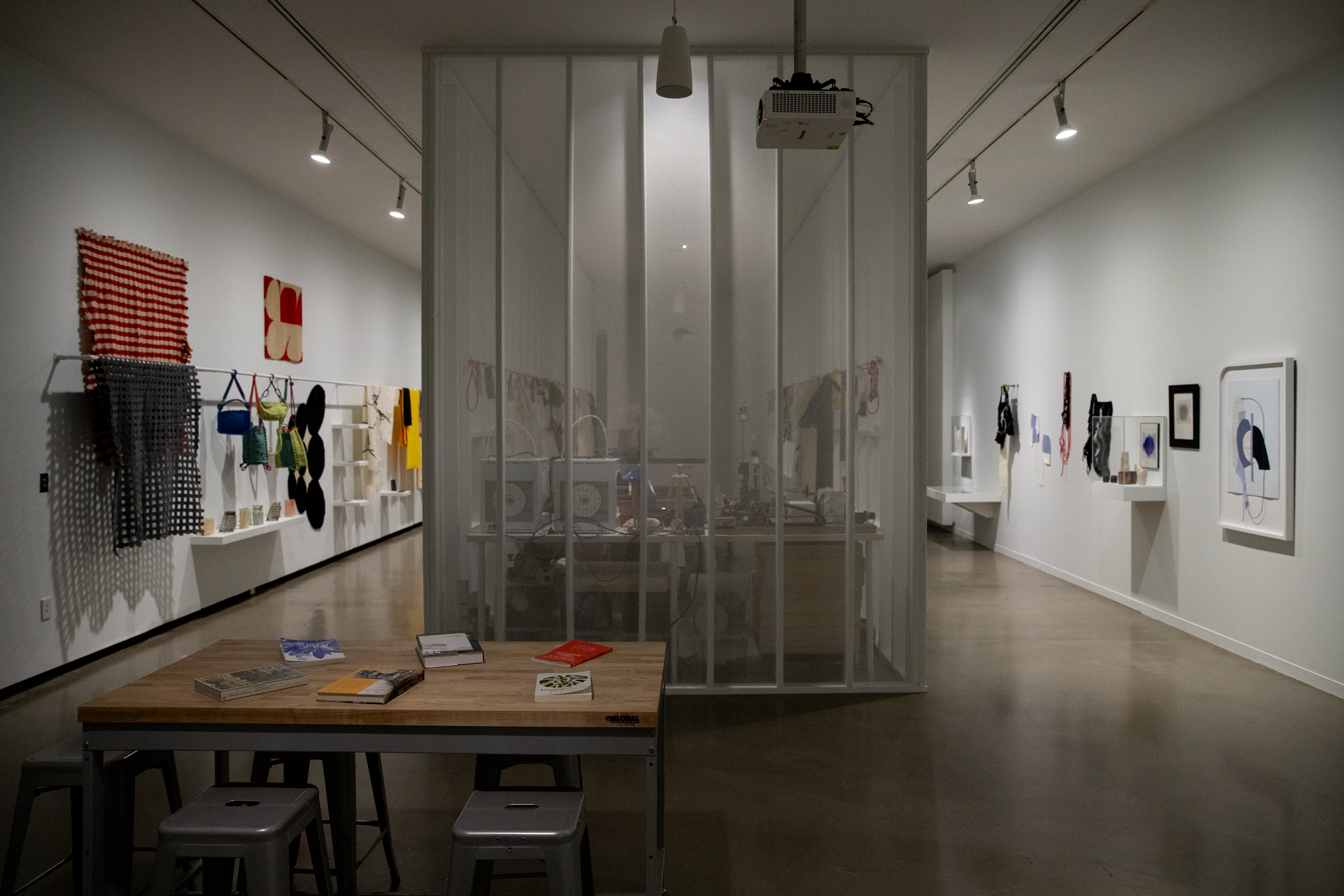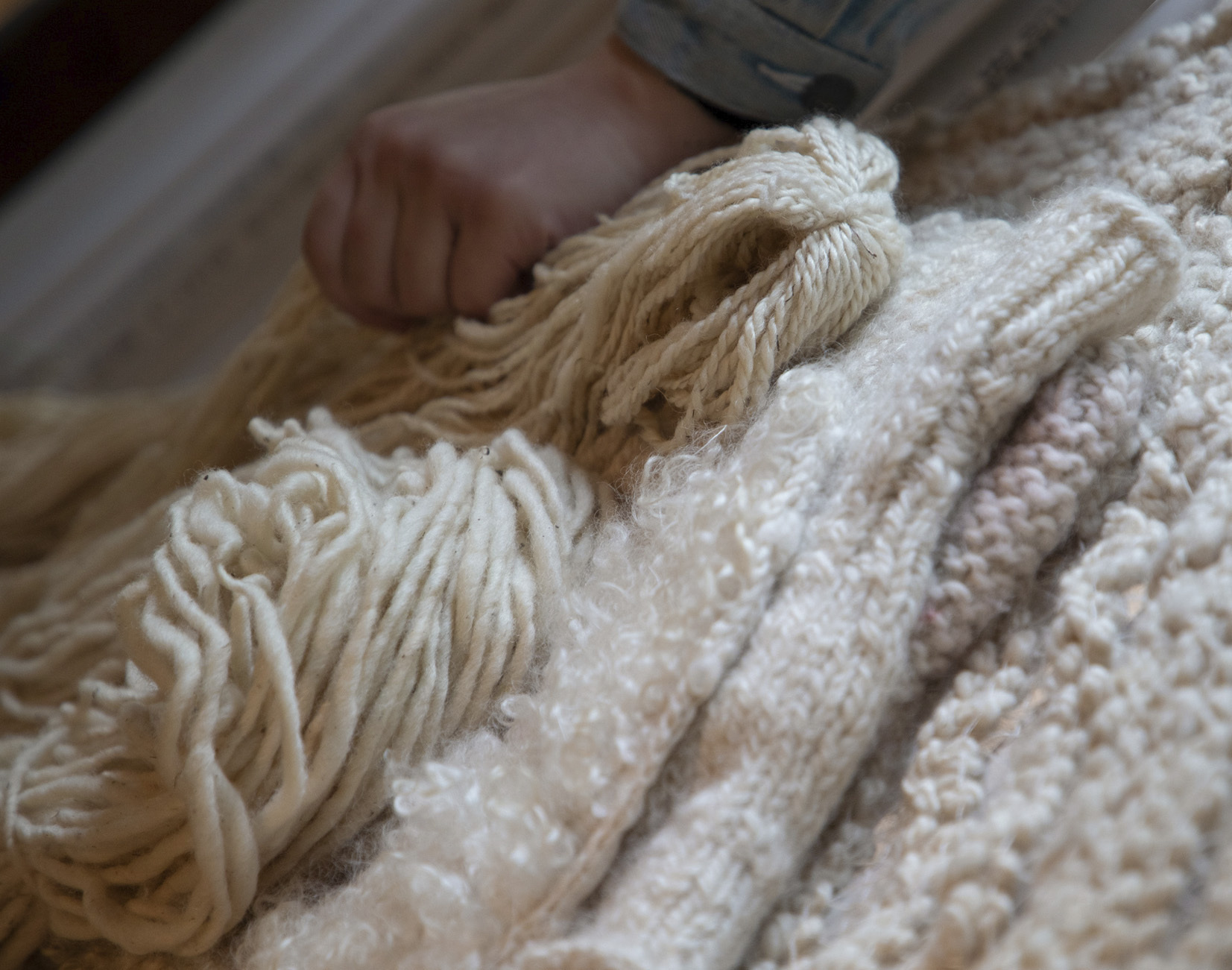Design Students Collaborate with Fibre Farmer to Find New Futures for Canadian Wool
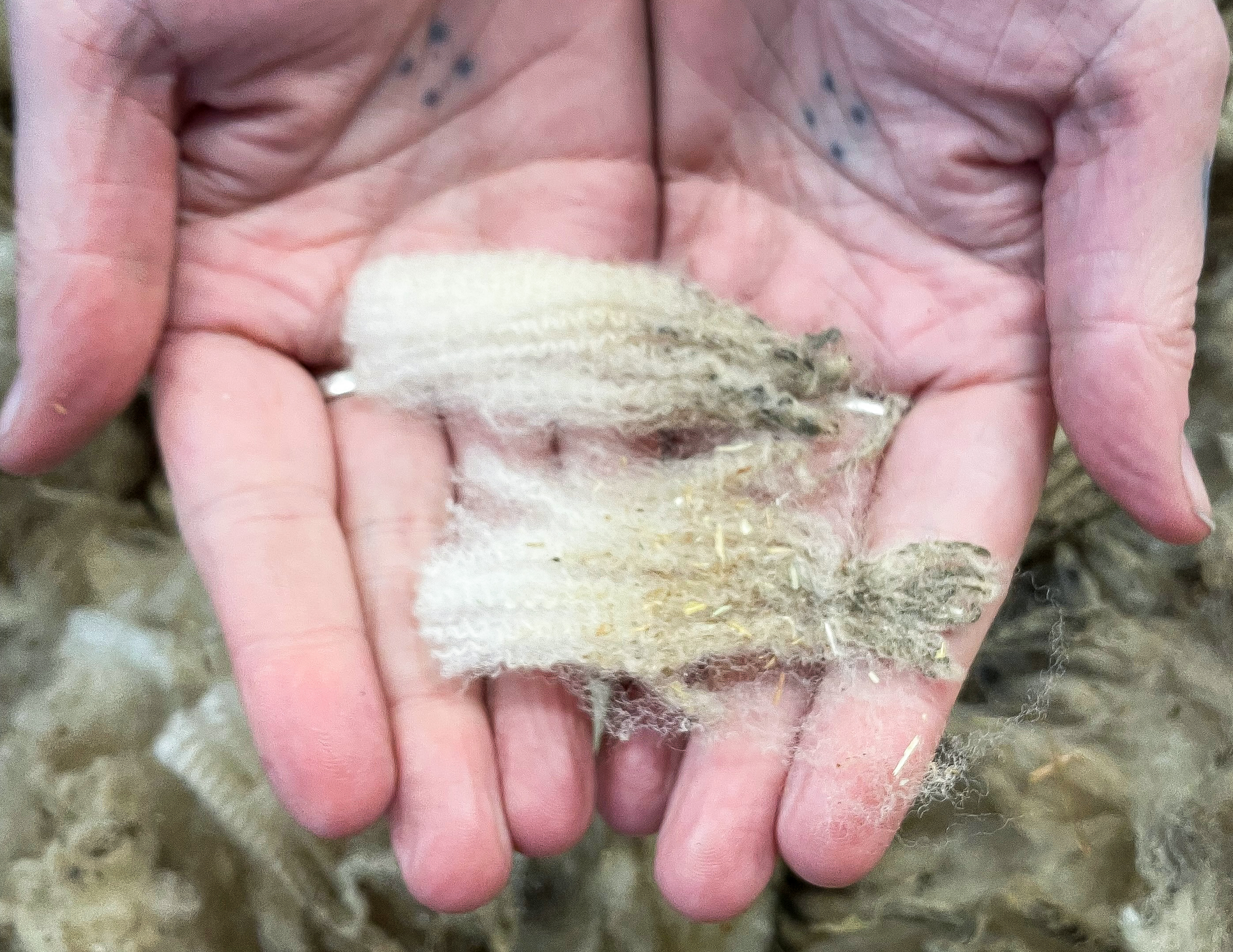
ECU MFA student Caitlin Ffrench cradles a sample of raw wool from Tara Klager's fibre farm during a class run as part of Hélène Day Fraser's WITH Wool project. (Photo courtesy Tara Klager / Hélène Day Fraser)
Posted on | Updated
A recent project brought Providence Lane Homestead cofounder Tara Klager into collaboration with faculty member Hélène Day Fraser’s industrial design class.
A recent class project saw industrial design students exploring new ways to help Canadian sheep farmers prevent wasted wool.
Led by designer and ECU faculty member Hélène Day Fraser, the WITH Wool project brought farmer and writer Tara Klager to the city with bags of raw fleece in tow. Tara is cofounder of Providence Lane Homestead in Alberta, Canada’s only fibre farm certified by A Greener World as Animal Welfare Approved.
“I felt like maybe with innovation from the younger generation of designers, we could develop a market for Canadian wool,” she tells me. “And I just loved the young people at Emily Carr. I loved their optimism. I loved their curiosity. They asked great questions. They were engaged. I just really appreciated the way they were willing to try. That was exciting.”
According to Tara, Canadian wool has gone from a sought-after material to a waste product over the past half-century.
“What used to be a significant commodity has become junk,” she tells me. Hand-spinners, weavers and other specialists take small amounts of wool from farmers, she continues. But the quantities they use aren’t substantial enough to offer meaningful support to farmers. And even large-scale, industrial buyers currently only pay around 30 cents per pound for wool.
“That doesn’t even cover my shearing,” Tara says. “I can’t get the wool off the animal for that. When you combine that with the time, effort and money it takes for processing, it’s very difficult to make money exclusively with wool.”
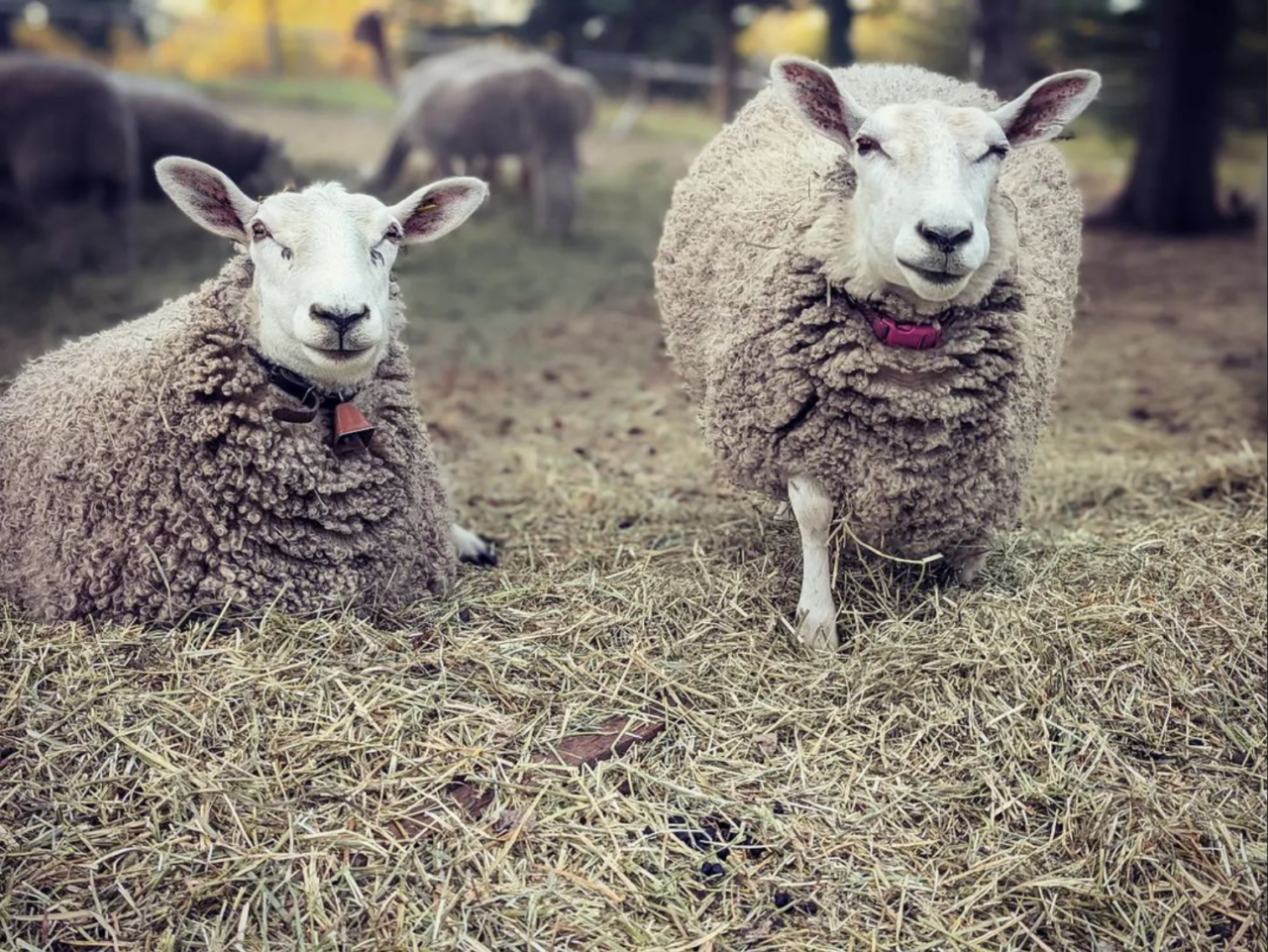
Jenny and Lizzy, two of Tara Klager's registered, purebred Border Leicester lambs, at Providence Lane Homestead. (Photo via Instagram / courtesy Tara Klager)
Consequently, most farmers focus on raising sheep for meat. Wool, meanwhile, has become a nearly worthless byproduct.
“A lot of sheep farmers throw it out, compost it, burn it, bury it, stick it in the chicken coop,” Tara says. “With all that happening, these folks are leaving money on the table. If there was a way we could revitalize the wool industry in Canada, it would be an income stream for these folks.”
Tara and Hélène first met through the Fibreshed movement. Similar to a watershed, a fibreshed is based on the idea of sustainably developing a material resource in close proximity to the landscape where it’s produced. The values behind this movement align closely with those of regenerative agriculture and permaculture, which Tara practices.
WITH Wool is part of a broader project titled New? Material! Relations. from the Material Matters research hub at ECU. This umbrella project aims to change unsustainable practices through dialogue, co-creative design and knowledge-sharing. The project includes a focus on developing new strategies for working with natural materials as alternatives to petroleum-based materials (such as plastics).
After working with Tara’s wool for weeks, students proposed a range of new ways it might be used. One group learned that wool naturally absorbs the harmful volatile organic compounds (VOCs) produced by wildfires. Intriguingly, wool does not re-release these trapped VOCs back into the air, even when burned. With wildfires on the rise globally, students noted the capacity of wool to act as a filter to clean smoky air as it enters homes under doors and around imperfectly sealed windows.
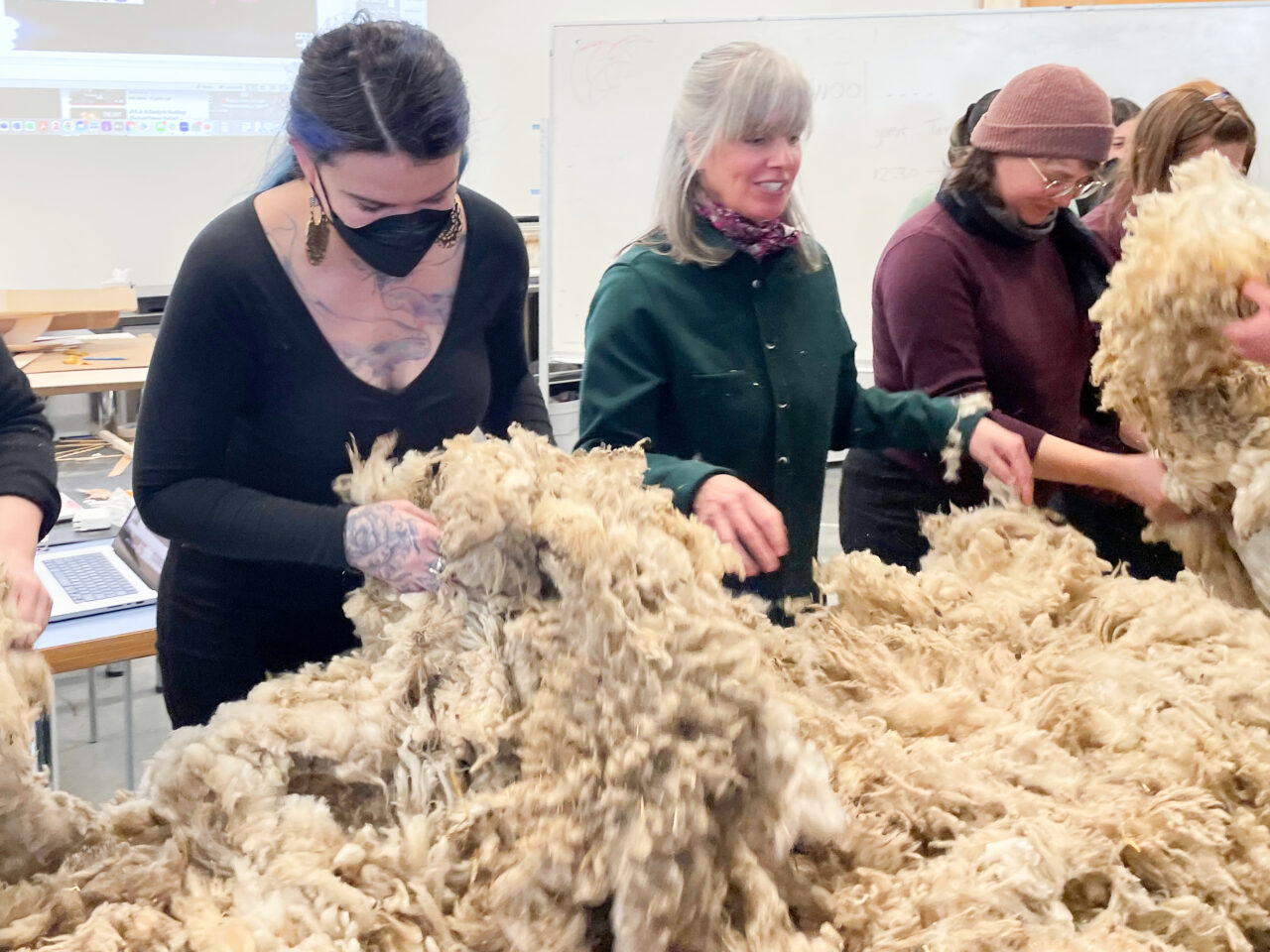
Tara Klager (centre) introduces her raw wool to students including Caitlin Ffrench (left) and Melanie Camman (right). (Photo courtesy Tara Klager / Hélène Day Fraser)
Because wool is recognized as the most flame-resistant natural fibre, students also designed a layered wool mat that doubles as an emergency blanket. The modular, petal-shaped textile could be used in normal everyday circumstances. But during emergency evacuation due to wildfire, the item could be used as a protective garment for children. The wool wrap would protect them from falling embers while also providing a sense of security.
“The fires we’re dealing with are these horrible, life-altering, devastating events. So what can we do with something that is a natural part of our environment?” Tara says. “I found that really inspiring, and I loved their focus on that. Not just on the fire suppression, but they really put a lot of thought into how we can make people feel better. This wool blanket is cozy, warm, comforting. As a small child, to have something familiar you can snuggle into that smells and feels like home, psychologically, emotionally, I would imagine that would be very precious.”
Another group discovered beeswax absorbs and neutralizes the smell of raw wool. They combined the wax and fleece to create compostable containers for nurseries to replace the ubiquitous plastic pots.
Tara notes these ideas all point to the strength of the latent Canadian fibre industry.
“Whether it’s wool, alpaca or other kinds of natural fibres, we have an incredible capacity here, and this is not new technology. This is extremely old,” she says. “There is potential here waiting for revitalization. We just need to apply some new thinking to a very old-world skill and material.”

Molded pots (left) and a felted pot created by ECU student Kamila Bashir using beeswax and raw wool from Tara Klager's fibre farm. (Photo courtesy Hélène Day Fraser)
But more importantly, WITH Wool underscores the benefits of collaborating across the so-called urban-rural divide.
“When we understand and invest in each other, we’re able to help solve each other’s problems and provide support to one another,” she says. “Whether we’re trying to heal land or supply chains or value chains or even dynamics between groups, I think that starts with a commitment to real communication.”
Tara recently appeared at the Responsible Visions + Neglected Materials panel discussion at Vancouver Art Gallery on Oct. 5, as part of Material Matters’ Lab: Here//Too//For public forum series. Follow Providence Lane Homestead on Instagram and Facebook to learn more about Tara’s work.
Visit Material Matters online and follow them on Instagram to stay up-to-date with their huge range of ongoing research projects.
Visit the ECU website to learn about studying Industrial Design at Emily Carr.

